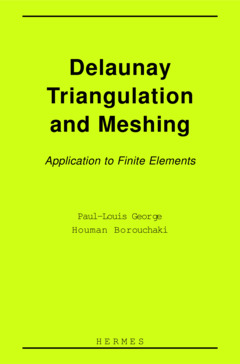Description
Delaunay triangulation and meshing : application to finite elements.
Authors: GEORGE Paul-Louis, BOROUCHAKI Houman
Language: English
Subject for Delaunay triangulation and meshing : application to...:
85.00 €
Subject to availability at the publisher.
Add to cart
Publication date: 05-1998
414 p. · 16x24 cm · Hardback
414 p. · 16x24 cm · Hardback
Description
/li>Contents
/li>
Automatic mesh generation is of the utmost importance in various engineering domains. Any numerical simulation based on spatial discretization, such as those involved in finite element methods, faces this mesh generation problem. In fact, the mesh is an essential pre-requisite as the quality of the resulting solution is strongly related to the element shape and size qualities. Thus, mesh generation has an economical impact on a wide range of engineering applications. The purpose of this book is to provide a comprehensive description of the meshing techniques based on the so-called Delaunay triangulation. To this end, it benefits from the experience acquired in the Gamma project at INRIA which has been in existence for many years. Both theoritical and computational aspects are discussed from a very practical point of view. Consequently, this book is intended for graduate students, researchers and also engineers dealing on a daily basis with mesh generation problems. Delaunay triangulation and meshing first addresses triangulation construction methods, then discusses classical mesh generation techniques along with more advanced topics such as anisotropic meshing. Planar, curve, surface and volumetric meshing issues are successively envisaged. Key issues for mesh adaptation are also highlighted. Various application examples from both the academic and concrete engineering areas are provided to illustrate the theoretical discussion.
1. Triangle, tetrahedron, triangulation, mesh 2. Delaunay triangulation 3. Constrained triangulation 4. Anisotropic triangulation 5. Meshing in two dimensions 6. Parametric surface meshing 7. Meshing in three dimensions 8. Optimizations 9. Mesh adaptation 10. Data structures 11. Boundary meshing 12. Finite element applications 13. Other applications. Bibliography. Index.
© 2024 LAVOISIER S.A.S.
These books may interest you

Delaunay Mesh Generation 129.87 €


